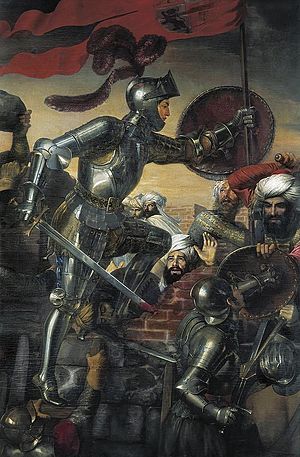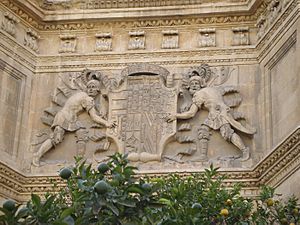Gonzalo Fernández de Córdoba facts for kids
Quick facts for kids
El Gran Capitán
|
|
|---|---|
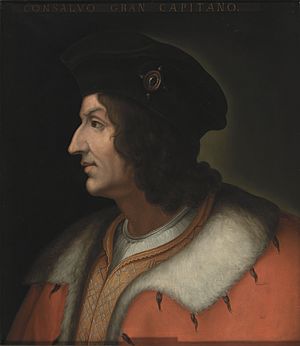
Posthumous portrait, 1877
|
|
| Nickname(s) | El Gran Capitán ("The Great Captain") |
| Born | 1 September 1453 Montilla, Spain |
| Died | 2 December 1515 (aged 62) Granada, Spain |
| Allegiance | |
| Years of service | 1482–1504 |
| Rank | General |
| Battles/wars |
|
| Other work | Viceroy of Naples (1504–1507) |
Gonzalo Fernández de Córdoba (born September 1, 1453 – died December 2, 1515) was a famous Spanish general and important leader. He led successful armies during the Conquest of Granada and the Italian Wars. Because of his many military wins and how popular he was, people called him "El Gran Capitán" ("The Great Captain").
He also helped make the final agreement for Granada to surrender. Later, he served as the Viceroy of Naples, which was like being a governor. Gonzalo was a very smart military planner. He was one of the first in Europe to use firearms successfully in battles. He also changed his army's foot soldiers to use both long spears (pikes) and firearms together. These changes made the Spanish army very strong for over 150 years. For his great success, he was given many important titles, like Duke of Santángelo (1497) and Duke of Sessa (1507).
Contents
Early Life and Military Beginnings
Gonzalo Fernández de Córdoba was born on September 1, 1453, in Montilla, a town in Spain. He was the younger son of a count. When Gonzalo was two years old, his father died. His older brother inherited everything, so Gonzalo had to make his own way.
In 1467, Gonzalo joined the household of Prince Alfonso, who was the half-brother of King Henry IV of Castile. After Prince Alfonso died in 1468, Gonzalo became a loyal supporter of Alfonso's sister, Isabella.
When King Henry IV died in 1474, Isabella said she should be the next queen. But her niece, Juana, also wanted the throne. This led to a civil war. Portugal's king sided with Juana. Gonzalo fought for Isabella and showed great bravery. In 1479, he led 120 lancers in the final battle against the Portuguese. He was praised for his excellent service. When the war ended, Isabella and her husband Ferdinand became the rulers of Castile and Aragon.
Conquering Granada
After Isabella and Ferdinand (known as the Catholic Monarchs) became strong rulers, they started a ten-year war in 1481. Their goal was to conquer Granada, the last Muslim kingdom in Spain. Fernández de Córdoba was a key player in this war. He became known as a brave and skilled military leader.
He was famous for his part in attacking walled towns like Loja and Montefrío. At Montefrío, he was said to be the first soldier to climb over the walls. In 1492, Fernández de Córdoba captured the city of Granada, which ended the war. He was good at both building military defenses and fighting like a guerilla fighter (using surprise attacks). Because he knew Arabic and was familiar with Boabdil, the last Muslim ruler of Granada, Gonzalo was chosen to help arrange the surrender.
For his service, he received land and other rewards.
Italian Campaigns
Gonzalo was a very important military leader during the Italian Wars. He led armies twice and earned his famous nickname, "The Great Captain."
First Italian War
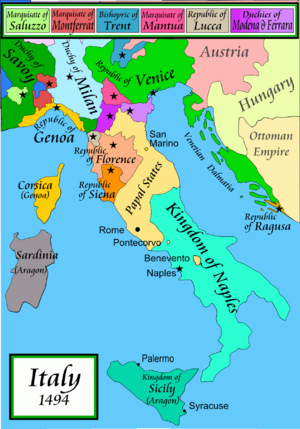
The Italian Wars started in 1494. Charles VIII of France marched into Italy with a huge army of 25,000 men. He wanted to claim the Kingdom of Naples, which was ruled by Ferdinand II, a cousin of Ferdinand of Aragon. The French easily defeated Naples. In May 1495, Charles crowned himself Emperor of Naples.
The Spanish rulers wanted to stop France's success in Naples. They chose Fernández de Córdoba to lead a Spanish army against Charles. Fernández de Córdoba arrived in Naples with about 5,000 foot soldiers and 600 light cavalry (soldiers on horseback). Charles feared being trapped, so he left some forces behind and returned to France.
At first, Fernández de Córdoba's light soldiers were not strong enough against the heavily armed French. Also, his Spanish and Italian forces were not well-trained or coordinated. In their first big battle on June 28, 1495, Fernández de Córdoba was defeated at the Battle of Seminara.
After this loss, Fernández de Córdoba pulled back. He started a tough training program and reorganized his army. The Spanish began using smart guerrilla tactics. They would strike quickly to cut off French supplies and avoid big battles. Slowly, Fernández de Córdoba gained control of the country again. He then attacked the Italian cities held by the French. Within a year, he won a major victory at Atella. He captured the French leader there and forced the remaining French out of Naples. By 1498, he had also taken back the Roman port of Ostia and returned the land to the Italians.
Military Changes
When Fernández de Córdoba returned to Spain, he used what he learned in Italy to improve the Spanish army. In open battles, Spanish foot soldiers with short swords could not stand against heavy cavalry and soldiers with long pikes. To fix this, Fernández de Córdoba introduced a new way of fighting. His foot soldiers now used both pikes and a heavy, shoulder-fired gun called an arquebus.
To make his army more flexible, he gave different parts of his forces specific jobs. This meant they could move and act more independently. These changes made the Spanish army much stronger and more adaptable.
Second Italian War
After Louis XII became king of France in 1498, he quickly said he would invade Italy again to take Naples. To buy time, Spain made a deal with France in 1500 called the Treaty of Granada. They agreed to split Naples between them.
Fernández de Córdoba went back to Italy with a large army. The excuse was to join France and Venice to fight the Ottoman Empire in the Ionian Sea. For a while, Fernández de Córdoba did fight the Turks. He captured the strong island of Cephalonia in December 1500 after a two-month siege.
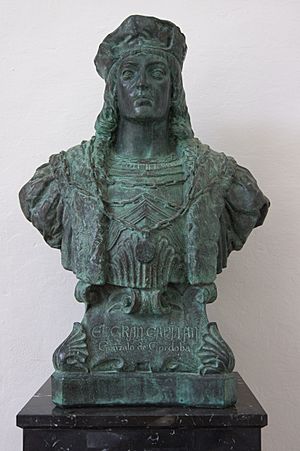
Fernández de Córdoba then returned to Naples. After Frederick IV gave up his throne, the French and Spanish fought a guerrilla war while trying to divide the kingdom. The Spanish army was outnumbered and trapped in Barletta by the French. Gonzalo refused to fight a full battle until he received enough extra soldiers.
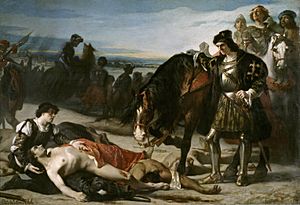
When his army was strong enough, Fernández de Córdoba attacked the French on April 28, 1503, at the Battle of Cerignola. About 6,000 Spanish troops faced a French army of 10,000. Gonzalo arranged his foot soldiers into units called coronelías. Pikemen were tightly packed in the center, and soldiers with arquebuses and swords were on the sides.
The French attacked the front but were hit by gunfire from the sides. The French commander was killed early in the battle. After stopping two French attacks, Fernández de Córdoba, El Gran Capitán, went on the attack and drove the French away. This was the first time in history that a battle was won mostly because of the power of firearms.
Fernández de Córdoba took control of Naples and pushed the French forces back across the Garigliano River. The river separated the armies, and neither side could advance. But Fernández de Córdoba built a temporary bridge and crossed the river on the night of December 29, 1503. The French were completely surprised because they thought the river was too high to cross due to rain. Fernández de Córdoba and his army decisively defeated the French using their pike and arquebus formations.
Fernández de Córdoba continued to chase the French. He captured the Italian city of Gaeta in January 1504. The French could not fight anymore after these losses. They were allowed to leave Italy by sea and had to sign the Treaty of Blois in 1505. This treaty made them give up their claim to Naples.
Viceroy of Naples and Later Life
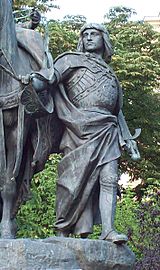
After the French were driven out of Naples, Fernández de Córdoba was made Duke of Terranova. He was also appointed Viceroy of Naples in 1504, which meant he governed the region. Later that same year, Queen Isabel I of Castile died. She had been his strongest supporter.
Isabella's death also temporarily weakened her husband, Ferdinand II of Aragon, in Castile. Naples was a kingdom belonging to Aragon, but Gonzalo was from Castile and very popular. Because of this, Ferdinand suspected Gonzalo's loyalty. He also felt that Gonzalo spent too much money from the treasury. In 1507, Ferdinand traveled to Naples, removed Gonzalo from his position, and ordered him to return to Spain. Ferdinand promised him a powerful and respected position as master of the Order of Santiago.
Although Fernández de Córdoba was given another title, Duke of Sessa, he never received the promised leadership role in the Santiago military order. Ferdinand continued to praise him but gave him no more work. Gonzalo eventually retired to one of his country estates. Fernández de Córdoba died from malaria on December 2, 1515, at his home near Granada. He was 62 years old.
Family Life
Fernández de Córdoba first married his cousin María de Sotomayor in 1474. She died about a year later while giving birth to a baby who did not survive. On February 14, 1489, he married María Manrique de Lara y Figueroa. She came from a powerful and rich noble family. His only surviving daughter, Elvira Fernández de Córdoba y Manrique, inherited all his titles when he died in 1515.
Legacy and Impact
"El Gran Capitán" was a pioneer of modern warfare. He completely changed military strategy in the 1500s. He was the first to fully use firearms in the Spanish army. He also led the first battle in history won mainly by gunpowder small arms (like the arquebus). This was the Battle of Cerignola in 1503.
He helped create the first modern standing army, known as the Spanish infantry. This army was almost unbeatable and controlled European battlefields for most of the 16th and 17th centuries. He also pioneered combined arms warfare. This means he combined foot soldiers, cavalry (soldiers on horseback), and artillery (large guns) with naval support (ships).
Gonzalo had no sons, so his daughter Elvira inherited his titles. His burial place is in the Monastery of San Jerónimo in Granada. It was built in the Renaissance style. His remains were moved there in 1552, along with about 700 war trophies (captured flags). His daughter, Elvira, and his wife, Maria, are also buried there.
Sadly, during the Peninsular War in 1810-1811, French troops damaged his tomb. Gonzalo's remains were taken out, and the 700 flags were burned. Stone from the monastery was used to build a bridge. The monastery was fully repaired at the end of the 1800s.
See also
 In Spanish: Gonzalo Fernández de Córdoba para niños
In Spanish: Gonzalo Fernández de Córdoba para niños


